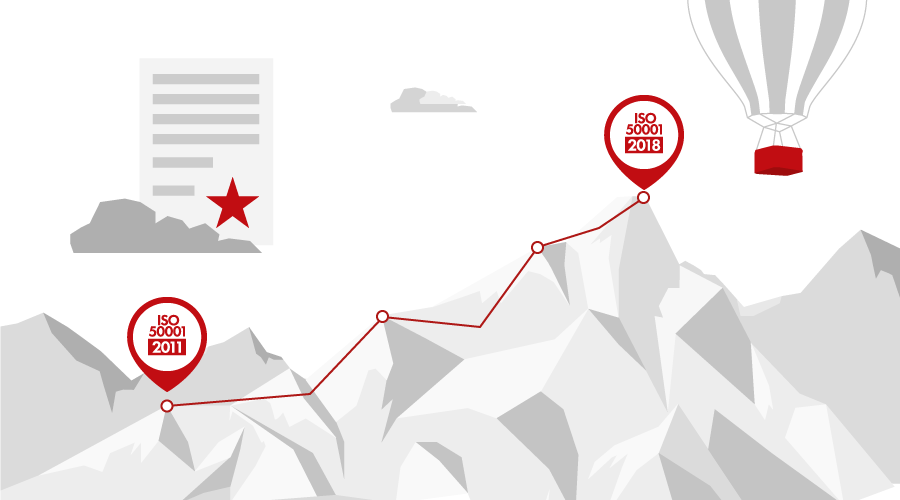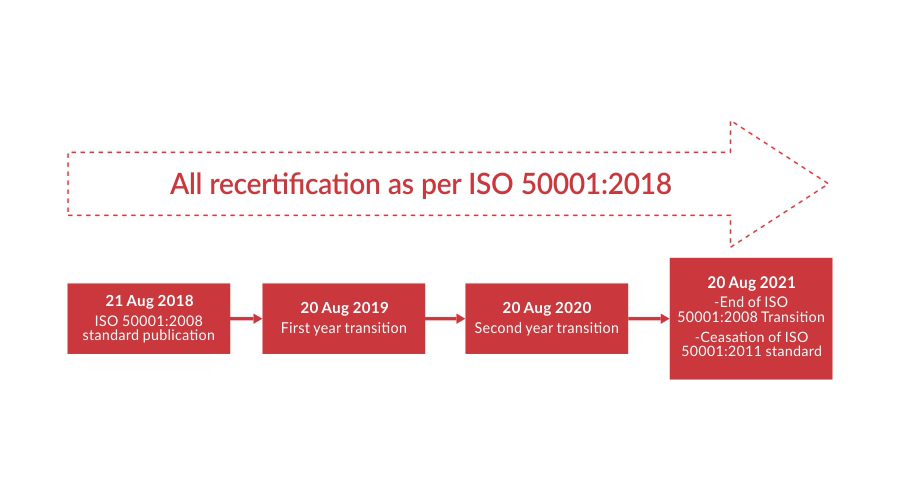
Evaluating the Key Changes in ISO 50001: ISO 50001:2011 to ISO 50001:2018
21st Nov, 2019
ISO 50001 is a framework that is largely used by organizations across the globe to implement efficient energy management system and to continually improve energy performance including energy efficiency, energy use and energy consumption.
International Organization for Standardization (ISO) updates all the ISO standards periodically. As per the ISO, High Level Structure has been adopted by most of the ISO standards, thus, ISO 50001:2018 also includes requirements induced by HLS, requirements of 50001:2011 and few new requirements that make the standard more effective. Apart from the HLS, there are certain changes for energy management as well as other sections.
Comparing in ISO 50001- ISO 50001:2011 to ISO 50001:2018
Following are the High-Level Structure (HLS) induced changes in ISO 50001:2018.
Understanding the Organization
It is applied that an organization shall determine external and internal issues relevant to its purpose that affect its ability to achieve the intended outcomes of its Energy Management System (EnMS) and also improve its energy performance. This can be considered a high-level understanding of influential factors affecting, negatively or positively, the energy performance and the EnMS of the organization.
To implement it successfully, you must identify and review the internal and external issues as explained in the standard. Some of the internal issues as per the standard could be financial resources such as labour, core business objectives and strategies which can include products, customers, competitors, key markets, trends in the industry, goals, etc. Further, external issues can be identified as issues related to interested parties such as existing national or sector objectives, requirements or standards, restrictions, energy costs etc.
Systematic determination of the needs and expectations of interested parties
The new clause requires determining relevant interested parties to energy performance and the EnMS, and their needs and expectations as well as requirements from a high-level perspective.
Required actions that can be taken to initiate the implementation include the review of the established objectives, targets, interested parties relevant with the energy-related legal and other requirements.
Leadership
The new standard emphasizes increased engagement for the effectiveness of the energy management system. Leaders can engage in the process including strategic planning, management and other required changes for energy performance improvement.
Risk and Opportunity Management
It is required to determine, and where necessary, take action to address any risks or opportunities that may impact, positively or negatively, on the ability of the management system to deliver its intended results.
You can identify risks and opportunities while planning the EnMS to anticipate potential scenarios and consequences to prevent undesired effects before they occur. Likewise, you can also identify favourable circumstances that could offer potential advantages or beneficial outcomes can be identified and pursued.
Competence
An organization must determine the necessary competence of people doing work under its control and that affects its energy performance and EnMS apart from the evaluation to measure the effectiveness of the actions taken to acquire competence.
You can review the defined competency and who it applies to in addition to ensuring it is not limited to the SEUs but for anybody who has an impact on the EnMS.
Extended Requirements for Communications
Focusing on the mechanics of the communication, the standard is addresses internal and external communication that determines what, when, how and who to communicate and with whom to communicate. The communication must lead to the consistent information generation within the EnMS.
You can ensure that communicated information is generated by the EnMS and consider documenting the information and improvement suggestions.
Operational Planning and Control
You must control the changes and review of the consequences of unintended changes (from HLS) while ensuring the control of outsourced Significant Energy Uses (SEU) or processes related to SEUs
You can document the information to acquire confidence that processes have been carried out as planned.
Monitor, Measure, Analyse and Evaluate the Energy Performance and EnMS
The standard requires the organization to determine the methods for monitoring, measuring, analysing and evaluating of the energy performance.
You can review the current practices to ensure evaluation of the EnMS and energy performances are included.
Here are the key changes made specific for energy management
First of all, the Section 4 that was Energy Management System Requirements is now divided into seven sections as flowed.
- Context of the Organization
- Leadership
- Planning
- Support
- Operation
- Performance Evaluation
- Improvement
The Scope
It is explicit that energy types within the scope and boundaries of the EnMS shall not be excluded. Organizations shall ensure that it has the authority to control its energy efficiency, energy use and energy consumption within the scope and boundaries.
Energy Review
Except the changes in a few terminologies, the standard states that there has to be a clarified process related to Significant Energy Uses (SEU) to create a logical flow and connected criteria.
You can identify SEUs and define relevant variables, current energy performance and identify persons that influence or affect the SEU. Also, you can develop estimates of future energy use and consumption at a higher level.
Energy Performance Indicators
The determined energy performance indicators (EnPIs) shall enable the organization to demonstrate energy performance improvement. The data that indicates the role of relevant variables that significantly affect energy performance shall be considered to establish appropriate EnPI(s) to ensure the EnPI is “fit for purpose”.
Energy Baseline
The relevant data that indicates the role of variables that significantly affect energy performance shall be considered to establish appropriate EnPl(s) while corresponding with the energy baseline to compare energy performance changes.
To implement it successfully, you can review relevant variables, determine EnPl(s) can be used for Energy Performance demonstration and which can be used for operational controls.
Planning for Collection of Energy Data
Replacing the term ‘Energy Measurement Plan’, the new one explicitly states that “The plan shall specify the data which is necessary to monitor the key characteristics and state how and at what frequency the data shall be collected and retained”. The data shall be collected for various areas including relevant variables, energy consumption and operational characteristics related to SEUs
You can review the energy data collection plan at defined intervals and updated as appropriate.
In other sections, key changes are made in design and procurement. It explicitly states that the performance over the planned or expected operating lifetime shall be looked at when considering energy improvement opportunities and operational control in the design of new, modified and renovated facilities, equipment etc. that can have a significant impact on its energy performance. It is required to define specifications, as applicable, for purchase of energy and also communicate those specifications. Specifications for energy performance of procured equipment and service must be defined and communicated, where applicable.
Transition Timeline
All the organizations that are currently certified to ISO 50001: 2011 have to complete the transition to ISO 50001: 2018 before August 20, 2021.

How to implement the new changes within your current EnMS?
If you have already applied ISO 50001:2011, you can recognize most of the requirements in the revised ISO 50001:2018. However, there are few complex changes that are challenging to integrate into the current system. In addition, it is necessary to complete the transition before August 20, 2021. As an ISO 50001 consultant, we have gained expertise over an extended period of time, as a result, we can provide you ISO 50001:2018 consulting and training to make your transition smooth as well as quick. So, in order to understand the new changes in-depth, get professional training, and complete the transition on time, you can reach out to the experts at 4C.
